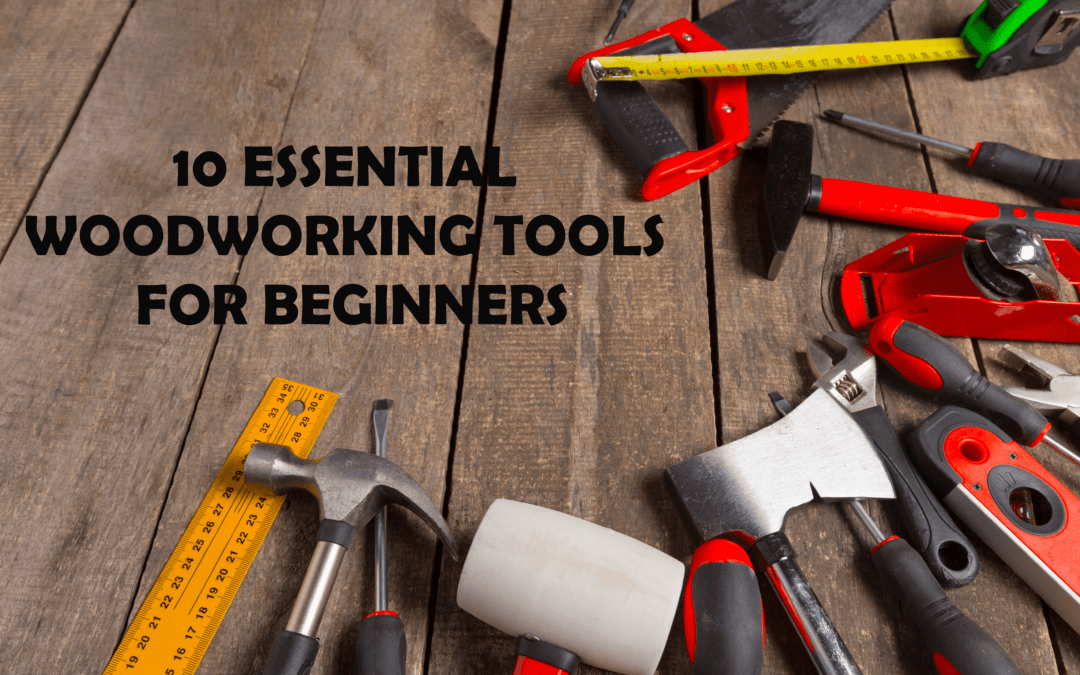Woodworking is a traditional and rewarding craft that has experienced a recent resurgence in popularity. It involves creating items from wood such as furniture, decorative pieces, and household items. Woodworking can be a fun hobby, a creative outlet, and even a profitable business. Regardless of why someone is interested in woodworking, having the right tools is essential to success.
In this article, we will provide an overview of the most essential tools for beginners in woodworking. These tools are crucial for completing any project, from small repairs to large pieces of furniture. We will also provide recommendations for quality tools that beginners can trust.
Top 10 Must-Have Tools for Woodworking Beginners :
- Hand Saw
- Power Drill
- Tape Measure
- Screwdrivers
- Hammers
- Chisels
- Clamps
- Sandpaper
- Plane
- Jigsaw
1. Hand Saw
 The hand saw is a staple in any woodworker’s toolbox. There are several types of hand saws, each designed for a specific purpose. Rip saws are used for cutting along the grain of wood, while crosscut saws are used for cutting across the grain. Other types of hand saws include tenon saws, dovetail saws, and back saws.
The hand saw is a staple in any woodworker’s toolbox. There are several types of hand saws, each designed for a specific purpose. Rip saws are used for cutting along the grain of wood, while crosscut saws are used for cutting across the grain. Other types of hand saws include tenon saws, dovetail saws, and back saws.
Using a hand saw provides several benefits. It allows for precision cuts, and it gives the woodworker more control over the cutting process. Hand saws are also more affordable than power tools, making them a great option for beginners.
For beginners, it is recommended to start with a good quality crosscut saw. This type of saw can handle a wide range of cuts and is a great choice for any project.
2. Power Drill
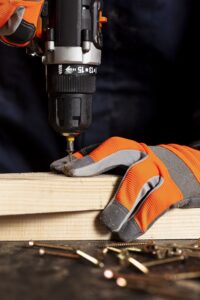 A power drill is another essential tool for woodworkers. Power drills are designed for speed and efficiency and are ideal for drilling holes in wood. There are several types of power drills, including corded and cordless options.
A power drill is another essential tool for woodworkers. Power drills are designed for speed and efficiency and are ideal for drilling holes in wood. There are several types of power drills, including corded and cordless options.
Power drills provide several benefits to woodworkers. They are faster and easier to use than hand drills, and they can handle much larger and more challenging projects. Power drills are also more versatile, as they can be used with a variety of drill bits and accessories.
For beginners, it is recommended to start with a good quality cordless drill. This type of drill is convenient and easy to use, and it provides the versatility needed to handle a wide range of projects.
3. Tape Measure
 A tape measure is an essential tool for woodworkers. It is used to measure lengths, widths, and depths to ensure accurate cuts. There are several types of tape measures, including retractable, foldable, and lockable options.
A tape measure is an essential tool for woodworkers. It is used to measure lengths, widths, and depths to ensure accurate cuts. There are several types of tape measures, including retractable, foldable, and lockable options.
Using a tape measure provides several benefits to woodworkers. It allows for accurate measurements, reducing the risk of mistakes and wasted materials. Tape measures are also more convenient and efficient than other measuring tools, such as rulers or yardsticks.
For beginners, it is recommended to start with a good quality retractable tape measure. This type of tape measure is easy to use and provides quick and accurate measurements.
4. Screwdrivers
 Screwdrivers are a staple tool in any woodworker’s toolbox. They come in a variety of sizes and shapes to fit different types of screws, including Phillips, flathead, hex head screwdrivers, and Torx. It is important to have a set of screwdrivers with different tip sizes to accommodate various screw sizes.
Screwdrivers are a staple tool in any woodworker’s toolbox. They come in a variety of sizes and shapes to fit different types of screws, including Phillips, flathead, hex head screwdrivers, and Torx. It is important to have a set of screwdrivers with different tip sizes to accommodate various screw sizes.
The benefits of using screwdrivers are numerous. They allow you to easily tighten or loosen screws, making it possible to assemble and disassemble joints or pieces of furniture. Additionally, screwdrivers provide more leverage than your hands alone, making it easier to turn screws in tight spaces or when applying a lot of force.
For beginners, it is recommended to :
- invest in a high-quality set of screwdrivers of different sizes and types. This will ensure that you have the right screwdriver for any job that comes your way.
- Choose screwdrivers with comfortable grips and non-slip handles to prevent hand fatigue and improve precision.
- Consider purchasing a magnetic screwdriver, which can help keep screws in place as you work.
5. Hammers

Hammers are a crucial tool in woodworking and are used to drive nails, remove nails, and perform various other tasks. There are several different types of hammers that each serve a specific purpose.The most common type of hammer is the Claw Hammer, which is used for driving nails into wood. This type of hammer has a claw on one end that can be used to remove nails. Another popular type of hammer is Sledgehammer is a large and heavy hammer used for demolition work and heavy-duty tasks, such as breaking up concrete or asphalt. It is not commonly used in woodworking, but it is essential to have one in your toolkit if you plan on doing demolition work.

Using a hammer properly can make all the difference in the quality of your woodworking projects. A well-balanced hammer with a comfortable grip will make your job easier and more efficient.
For beginners, we recommend starting with a 16-ounce Claw Hammer. This type of hammer is lightweight, making it easy to use, and versatile enough to handle a variety of tasks. Investing in a high-quality hammer will ensure that it lasts a long time and performs well.
6. Chisels
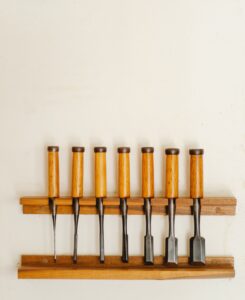 Chisels are an essential tool for woodworkers, and with the right chisels, you can create precise cuts and shapes in your wood projects. There are several types of chisels available, including mortise chisels, bench chisels, and carving chisels, each with its unique purpose.
Chisels are an essential tool for woodworkers, and with the right chisels, you can create precise cuts and shapes in your wood projects. There are several types of chisels available, including mortise chisels, bench chisels, and carving chisels, each with its unique purpose.
Benefits of using chisels include the ability to make clean, precise cuts and shapes in wood, which is essential for various woodworking projects. With a good set of chisels, you can make straight cuts, angled cuts, and even curved cuts in wood, which allows for more creative possibilities in your projects.
For beginners, we recommend starting with a set of bench chisels. These chisels are versatile and can be used for various tasks, such as chopping mortises, cutting dovetails, and more. Look for a set of chisels with beveled edges and a comfortable handle that will provide you with a good grip while you work. A good set of chisels is a valuable investment that will last you for years, so be sure to invest in a quality set.
7. Clamps
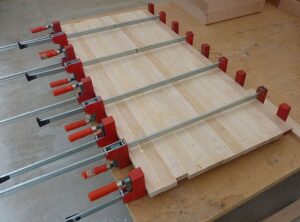 Clamps are essential tools in woodworking and play a vital role in holding materials together while working on a project. Here’s a brief explanation of different types of clamps and their benefits:
Clamps are essential tools in woodworking and play a vital role in holding materials together while working on a project. Here’s a brief explanation of different types of clamps and their benefits:
- C-Clamps: strong grip for holding irregularly shaped objects
- Bar Clamps: perfect for clamping long pieces of wood
- F-Clamps: versatile option for a range of clamping tasks
- Spring Clamps: great for light duty clamping tasks
The benefits of using clamps in woodworking are numerous. They help secure pieces of wood together while working on them, ensuring accuracy and preventing movement. They also allow for hands-free work, freeing up the woodworker’s hands to focus on other tasks. Additionally, clamps can be used to apply pressure to joints, helping to ensure a tight and secure fit.
For beginners, it is recommended to start with a basic set of bar clamps and C-clamps, as these will cover a wide range of clamping needs. As you progress in woodworking, you may also want to consider adding F-clamps to your collection for their quick and easy use. Regardless of the type of clamps you choose, it is important to invest in high-quality clamps that are durable and easy to use, as this will make your woodworking projects easier and more enjoyable.
8. Sandpaper : Essential for Finishing Touches

Explanation of different types of sandpaper: Sandpaper comes in a variety of grits, ranging from coarse to fine. Coarse sandpaper is ideal for removing rough surfaces, while fine sandpaper is used for smooth finishes.
Benefits of using sandpaper: Sandpaper is an effective tool that helps woodworkers achieve a smooth, polished finish. It helps remove rough spots and prepares the surface of wood for staining or painting.
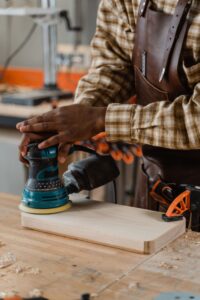
For beginners, it’s best to start with a set of sandpapers in various grits, including coarse, medium, and fine. A good quality sandpaper will make the finishing process much easier and produce a professional-looking result.
It is recommended to use sandpaper regularly,but carefully, to achieve the desired results. With the right sandpaper, the final touch of a project can elevate it to the next level, making it truly stand out.
9. planes
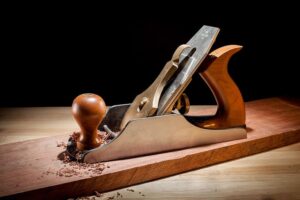 Planes are hand-held woodworking tools used for shaping and smoothing the surface of a piece of wood. There are several types of planes, including block planes, jack planes, smoothing planes, and plow planes, each with its own specific purpose.
Planes are hand-held woodworking tools used for shaping and smoothing the surface of a piece of wood. There are several types of planes, including block planes, jack planes, smoothing planes, and plow planes, each with its own specific purpose.
Using a plane allows for the precise and controlled removal of material from the surface of the wood, which results in a smoother and more accurate finish. Planes are also beneficial for removing any unevenness in the surface, making it easier to fit joints together.
For beginners, it’s recommended to start with a block plane or a jack plane, as they are the simplest to use. It’s also important to have a good quality blade, as this will greatly affect the accuracy and ease of use of the plane. Practicing on scrap wood before working on a project can help get a feel for the tool and improve technique.
10. Jigsaws:
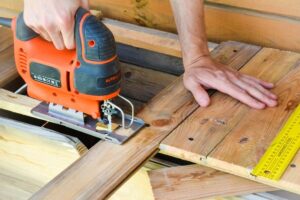
Jigsaws are power tools that use a reciprocating blade to cut through a variety of materials, including wood, metal, and plastic. They are often used for making curved or intricate cuts and are typically handheld, making them highly versatile and ideal for cutting in tight spaces.
Here’s a brief explanation of different types of jigsaws and their benefits:
- Corded jigsaws: Offer more power and are ideal for heavy-duty tasks.
- Cordless jigsaws: Offer mobility and convenience but may not have the same power as corded jigsaws.
- Barrel grip jigsaws: Have a pistol-style handle for better control and comfort.
- Top handle jigsaws: Have a top-mounted handle for improved balance and stability.
Using a jigsaw offers many benefits, including the ability to make precise cuts in a variety of materials, and the ability to easily change blades for different applications. Jigsaws are also relatively easy to operate and require minimal training, making them ideal for DIYers and hobbyists.
For beginners, it is important to choose a jigsaw that is comfortable to hold and has adjustable speed settings. It is also helpful to invest in a good set of blades, as well as safety equipment such as eye protection and ear protection, to ensure that you can work safely and efficiently. Additionally, practicing on scrap materials can help to build confidence and refine your technique before taking on more complex projects.
conclusion
Summary of Essential Tools for Woodworking Beginners: As a beginner in woodworking, it’s important to have a basic set of tools that will enable you to carry out different tasks. The list of essential tools includes a saw, hammer, screwdriver, drill, clamps, sandpaper, plane, chisel, and jigsaw.
Importance of Investing in Quality Tools: Quality tools can make a significant difference in the quality of your work. They are also more durable, which means you won’t have to replace them as often. Investing in quality tools also helps you work more efficiently and safely.
Final Recommendations for Beginners: It’s important to take your time when selecting your tools. Consider your needs, the types of projects you want to work on, and your budget. It’s also a good idea to invest in a good set of safety gear, such as goggles, gloves, and a dust mask. Finally, it’s important to properly maintain and store your tools to ensure they last a long time and remain in good condition.

